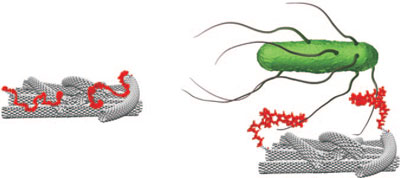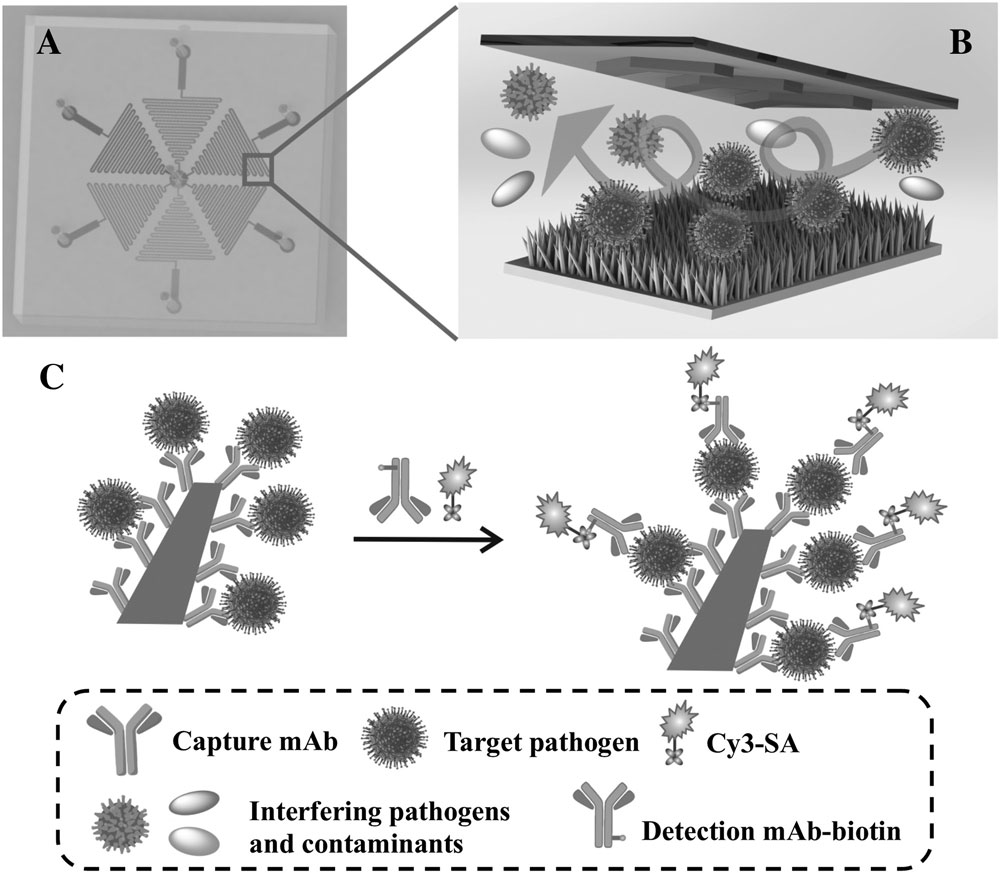Nanotechnology for foodborne pathogen detection
Many different disease-causing germs can contaminate foods (see: A-Z Index for Foodborne Illness), resulting in many different kinds of foodborne infections. Researchers have identified more than 250 foodborne diseases. Most of them are infections, caused by a variety of bacteria, viruses, and parasites. Harmful toxins and chemicals also can contaminate foods and cause foodborne illness.
Foodborne illness is a common, costly – yet preventable – public health problem. The Centers for Disease Control and Prevention (CDC) estimates that in the U.S. alone, each year 48 million people get sick from a foodborne illness, 128,000 are hospitalized, and 3,000 die. The U.S. Department of Agriculture (USDA) estimates that foodborne illnesses cost more than $15.6 billion each year.
These staggering numbers, not to mention the potential of foodborne pathogens for terrorists attacks, are driving the development of biosensors as important analytical tools for the rapid detection of pathogens.
Unfortunately, current detection techniques such as ISO method 6579, fluorescent-antibody (FA), enzyme-linked immunosorbent assay (ELISA), or polymerase chain reaction (PCR) are time-consuming, cumbersome, and have limited sensitivity. They are inadequate as they lack the ability to detect bacteria in real time.
Nanotechnology offers the opportunity for alternative sensor platforms for the rapid, sensitive, reliable and simple isolation and detection of E. coli and other pathogens. Nanotechnology enabled detection techniques include detections by luminescence using quantum dots; localized surface plasmon resonance of metallic nanoparticles; enhanced fluorescence; dye immobilized nanoparticles; or Raman reporter molecule immobilized metallic nanoparticles.
All the nanostructures used for the biosensing applications have two characteristics. First, they contain certain recognition mechanisms specified to the analyte, for example, antibodies or enzymes. Second, they are able to generate a distinguishing signal from the analyte and this signal could be generated by the nanostructures themselves or produced by signaling molecules immobilized or contained in the nanostructures.
Here are some examples:
Carbon nanotube based sensor detects living bacteria at ultralow concentrations
A carbon nanotube based potentiometric biosensor is able to selectively detect one single colony-forming unit of the bacterium Salmonella Typhi in close to real time.
To build their sensor, researchers linked carboxylated single-walled carbon nanotubes (SWCNT) to an aptamer. Aptamers are not only highly suitable receptors for the selective and high-proficiency detection of a wide range of molecular targets, including bacteria, they have also shown to self-assemble on carbon nanotubes.
The hybrid material aptamer-SWCNT acts as both the sensing and the transducing layer of the biosensor. The presence of target bacteria promotes a conformational change in the aptamer that separates the phosphate groups from the SWCNT sidewalls, inducing a charge change to the SWCNT and the subsequent change of the recorded potential.

Nanobiosensor for Salmonella detection
Three pathogens, Salmonella, Listeria, and Toxoplasma, are responsible for 1,500 deaths each year. Salmonella is the most common cause of foodborne deaths and responsible for millions of cases of foodborne illness a year. Sources are raw and undercooked eggs, undercooked poultry and meat, dairy products, seafood, fruits and vegetables – so basically more or less everything you eat.
Researchers have designed and fabricated a hetero-structured silicon/gold nanorod array and functionalized it with anti-Salmonella antibodies and organic dye molecules. Due to the high aspect ratio nature of the silicon nanorods, dye molecules attached to the silicon nanorods produce an enhanced fluorescence upon capture and detection of Salmonella (Nanotechnology, An Au/Si hetero-nanorod-based biosensor for Salmonella detection).
Graphene sensor for pathogen detection
A graphene based sensor design that can simultaneously detect multiple substances including dangerous bacteria and other pathogens (Optical Materials Express, "Hybridization-induced dual-band tunable graphene metamaterials for sensing").
For the new sensor, the researchers designed an array of nanoscale graphene disks that each contain an off-center hole. The sensor includes ion-gel and silicon layers that can be used to apply a voltage to tune the graphene's properties for detection of various substances.
The interaction between the disks and their holes creates what is known as the plasmon hybridization effect, which increases the sensitivity of the device. The hole and the disk also create different wavelength peaks that can each be used to detect the presence of different substances simultaneously.
Peptide nanotubes for highly sensitive pathogen sensors chips
Researchers have developed a label-free sensor chip assembled from peptide nanotubes that enables the electrical detection of viruses with an extremely low detection limit. This could lead to compact super-sensitive pathogen detection chips for point of care applications that have a high tolerance against false-positive signals.
One-step detection of pathogens and viruses with magnetic beads
A magnetic bead based sensor combines magnetic separation and magnetic relaxation switch for one-step detection of bacteria and viruses with high sensitivity and reproducibility. Compared to conventional assays for detection of bacteria and viruses, this assay is easy to operate without laborious pre-treatment, purification and can be adaptable to point-of-care tests easily.
Nanostructured microfluidics platform for pathogen detection
A new zinc oxide nanorods integrated microchip captures avian influenza virus on immunologically functionalized ZnO nanorod surface and detects viruses by multiplexed sandwich immunoassay.

This platform also has the capability for simultaneous detection of multiple viral pathogens by spatial encoding different antibodies onto the same chip.
 By
Michael
Berger
– Michael is author of three books by the Royal Society of Chemistry:
Nano-Society: Pushing the Boundaries of Technology,
Nanotechnology: The Future is Tiny, and
Nanoengineering: The Skills and Tools Making Technology Invisible
Copyright ©
Nanowerk LLC
By
Michael
Berger
– Michael is author of three books by the Royal Society of Chemistry:
Nano-Society: Pushing the Boundaries of Technology,
Nanotechnology: The Future is Tiny, and
Nanoengineering: The Skills and Tools Making Technology Invisible
Copyright ©
Nanowerk LLC
